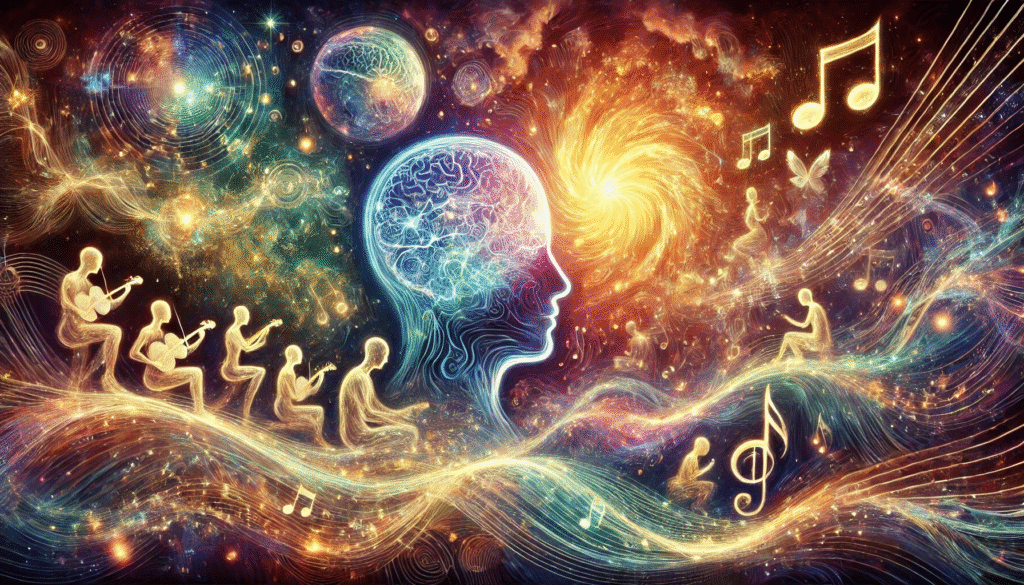
ChatGPT:
Music has always been more than art — it is a form of medicine embedded in human culture since the beginning of time. In I Heard There Was a Secret Chord, neuroscientist and musician Daniel J. Levitin explores how music shapes the brain, heals the body, and fosters resilience. Through neuroscience research, case studies, and cultural traditions, he shows that music is not just an emotional companion but a tool for survival, therapy, and social connection.
Music as a Biological Necessity 🎶
Evolutionary Origins
- Music predates language in human communities, serving as a means of emotional communication and social bonding.
- Rhythms and chants were used in early rituals to synchronize group activity and enhance cohesion.
- Infants naturally respond to lullabies, suggesting that music is wired into human biology.
Neurological Foundations
- Unlike most activities, music activates nearly the entire brain: auditory cortex, motor areas, limbic system, and prefrontal cortex.
- This wide activation explains music’s power to influence mood, memory, movement, and healing.
- Neuroplasticity — the brain’s ability to reorganize — is enhanced by musical training and listening.
Music and the Brain 🧠
Memory and Emotion
- Music bypasses damaged memory circuits in dementia patients, enabling them to recall lyrics and emotions tied to songs.
- Familiar tunes can evoke vivid autobiographical memories, reconnecting individuals to their identities.
Movement and Rehabilitation
- Rhythmic auditory stimulation helps stroke and Parkinson’s patients regain motor coordination.
- Music therapy is used in rehabilitation clinics to retrain walking patterns and improve balance.
Stress and Hormones
- Slow-tempo music lowers cortisol and adrenaline, while upbeat rhythms stimulate dopamine release.
- Guided music listening has been shown to reduce surgical anxiety and perceived pain.
Cultural Traditions of Healing 🪘
- Indigenous drumming ceremonies promote trance states that relieve pain and trauma.
- Chanting in religious contexts (Gregorian chants, Buddhist mantras) aligns breathing and induces calm.
- Music in communal rituals strengthens social bonds, reinforcing collective healing.
Music Across the Lifespan 👶👵
Infants and Children
- Lullabies regulate breathing and heart rhythms, fostering attachment between caregiver and child.
- Musical play boosts language acquisition, rhythm perception, and motor coordination.
Adults and Aging
- In adulthood, music provides stress relief, emotional regulation, and opportunities for social connection.
- In aging populations, it preserves cognitive function, strengthens memory, and provides comfort in end-of-life care.
Clinical Applications 🏥
Pain Management
- Patients exposed to calming music before and after surgery report lower pain levels and reduced need for sedatives.
Neurological Disorders
- In Alzheimer’s, familiar songs unlock lost memories, enabling communication when language fails.
- For Parkinson’s, rhythmic entrainment helps patients initiate and sustain movement.
Trauma and Mental Health
- Veterans with PTSD benefit from songwriting workshops and group drumming, which help process trauma.
- Guided improvisation enables safe emotional expression and reduces symptoms of anxiety.
Social Power of Music 🤝
- Group singing synchronizes breathing, heart rate, and brain waves, creating physiological unity.
- Choirs and drumming circles foster empathy, belonging, and emotional resilience.
- Music strengthens collective identity in protests, religious gatherings, and national rituals.
The Future of Music as Medicine 🔮
- Levitin argues for broader integration of music into healthcare systems.
- Personalized playlists may serve as prescriptions tailored to patient needs.
- Advances in neuroscience will help refine how specific rhythms, frequencies, and harmonies affect healing.
- Music therapy offers a low-cost, side-effect-free complement to pharmaceuticals.
Conclusion
Daniel J. Levitin presents a compelling case for music as a universal form of medicine. Across cultures, generations, and conditions, music soothes, heals, and connects. From reducing surgical pain to reviving memory in dementia, music’s therapeutic power is undeniable. It is both ancient and modern — a human invention rooted in biology and refined through science. Levitin’s book leaves us with a clear message: music is not optional; it is vital to health, resilience, and human connection.
Quotes from
I Heard There Was a Secret Chord: Music as Medicine
— Daniel J. Levitin
Here are key insights and life-guiding reflections drawn from the book (no timestamps since it’s a book, not a video):
- “Music is not a luxury but a biological necessity.”
→ Levitin emphasizes that music is as essential to human survival and health as food and sleep. - “When language fails, music remembers.”
→ On how dementia patients reconnect with their identity through familiar songs. - “The brain doesn’t just hear music; it moves with it, feels with it, heals with it.”
→ Explaining why music therapy engages multiple systems at once. - “A lullaby is medicine in melody.”
→ Highlighting the role of music in regulating infants’ physiology and emotional security. - “Every culture has used rhythm and song to heal long before modern medicine existed.”
→ A reminder of music’s universal and timeless healing role. - “Pain is not only reduced by drugs but by the right harmony.”
→ On the use of music in clinical pain management. - “In trauma, words can wound; music can repair.”
→ The therapeutic value of songwriting and drumming for veterans and PTSD patients. - “When we sing together, our hearts literally beat as one.”
→ Describing the physiological synchrony created by group singing. - “Music therapy works because it speaks the brain’s native language — rhythm, tone, and emotion.”
→ A neuroscientific explanation of why music reaches deeper than words. - “To heal with music is to return to what humans have always known: the body dances, the spirit sings.”
→ Levitin’s vision of music as an ancient yet scientifically validated medicine.

